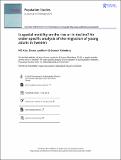Files in this item
Is spatial mobility on the rise or in decline? An order-specific analysis of the migration of young adults in Sweden
Item metadata
| dc.contributor.author | Kulu, Hill | |
| dc.contributor.author | Lundholm, Emma | |
| dc.contributor.author | Malmberg, Gunnar | |
| dc.date.accessioned | 2018-04-18T11:30:06Z | |
| dc.date.available | 2018-04-18T11:30:06Z | |
| dc.date.issued | 2018-10 | |
| dc.identifier | 251333314 | |
| dc.identifier | ad0508a9-7c05-4773-a256-ee614b98ce5f | |
| dc.identifier | 85045449598 | |
| dc.identifier | 000456729900003 | |
| dc.identifier.citation | Kulu , H , Lundholm , E & Malmberg , G 2018 , ' Is spatial mobility on the rise or in decline? An order-specific analysis of the migration of young adults in Sweden ' , Population Studies , vol. 72 , no. 3 , pp. 323-337 . https://doi.org/10.1080/00324728.2018.1451554 | en |
| dc.identifier.issn | 0032-4728 | |
| dc.identifier.other | ORCID: /0000-0001-8808-0719/work/75996975 | |
| dc.identifier.uri | https://hdl.handle.net/10023/13156 | |
| dc.description | The study was supported by a research grant from the Economic and Social Research Council [ES/L01663X/1] under the Open Research Area Plus scheme. | en |
| dc.description.abstract | The aim of this study is to investigate spatial mobility over time. Research on ‘new mobilities’ suggests increasing movement of individuals, technology, and information. By contrast, studies of internal migration report declining spatial mobility in recent decades. Using longitudinal register data from Sweden, we calculate annual order-specific migration rates to investigate the spatial mobility of young adults over the last three decades. We standardize mobility rates for educational enrolment, educational level, family status, and place of residence to determine how much changes in individuals’ life domains explain changes in mobility. Young adults’ migration rates increased significantly in the 1990s; although all order-specific migration rates increased, first migration rates increased the most. Changes in population composition, particularly increased enrolment in higher education, accounted for much of the elevated spatial mobility in the 1990s. The analysis supports neither ever increasing mobility nor a long-term rise in rootedness among young adults in Sweden. | |
| dc.format.extent | 15 | |
| dc.format.extent | 1245311 | |
| dc.language.iso | eng | |
| dc.relation.ispartof | Population Studies | en |
| dc.subject | Migration | en |
| dc.subject | Mobility | en |
| dc.subject | Life course | en |
| dc.subject | Young adults | en |
| dc.subject | Standardization | en |
| dc.subject | Order-specific analysis | en |
| dc.subject | Sweden | en |
| dc.subject | GF Human ecology. Anthropogeography | en |
| dc.subject | H Social Sciences (General) | en |
| dc.subject | 3rd-DAS | en |
| dc.subject | BDC | en |
| dc.subject | SDG 4 - Quality Education | en |
| dc.subject.lcc | GF | en |
| dc.subject.lcc | H1 | en |
| dc.title | Is spatial mobility on the rise or in decline? An order-specific analysis of the migration of young adults in Sweden | en |
| dc.type | Journal article | en |
| dc.contributor.institution | University of St Andrews. School of Geography & Sustainable Development | en |
| dc.identifier.doi | 10.1080/00324728.2018.1451554 | |
| dc.description.status | Peer reviewed | en |
| dc.date.embargoedUntil | 2018-04-17 |
This item appears in the following Collection(s)
Items in the St Andrews Research Repository are protected by copyright, with all rights reserved, unless otherwise indicated.

